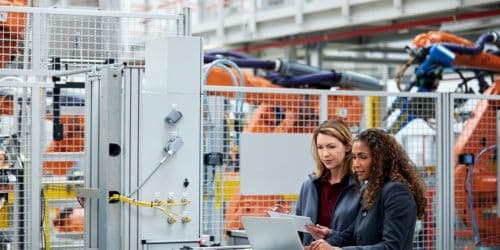Industry 4.0 is a term used to describe the fourth industrial revolution, even though it focuses on topics that are not typically categorized as industry applications in and of themselves. Industry 4.0 is transforming how manufacturing firms use technology to enhance and distribute their goods. The Internet of Things (IoT), cloud computing, analytics, artificial intelligence (AI), and machine learning are among the cutting-edge technologies that manufacturers are incorporating into their manufacturing processes. All industrial businesses, including those in discrete and process manufacturing, oil and gas, mining, and other industrial sectors, can make use of Industry 4.0 concepts and technologies.
What Is Industry 4.0
One way to describe Industry 4.0 is the integration of intelligent digital technologies into industrial and manufacturing processes. Manufacturing can be made smarter and more intelligent factories can be built thanks to Industry 4.0. With more informed choices and customization options available, it aims to increase productivity, efficiency, and adaptability in manufacturing and supply chain operations.
The Fourth Industrial Revolution promotes “smart factories,” as they are known. The concept of a “Smart Factory” is a production setting where production facilities and logistics systems are set up without the need for human intervention. An array of cyber-physical systems that communicate with one another through the Internet of Things and Services make up the Smart Factory, also known as an intelligent factory. Furthermore, a key step in this process is the data transfer between the product and the production line. As a result, the Supply Chain can be linked much more effectively, and any production environment can be better organized.
Known also as Industry 4.0, we are currently experiencing the fourth industrial revolution. Informed data enables more efficient and productive manufacturing across the value chain, which is characterized by rising automation and the use of intelligent machines and factories. Mass customization allows for greater flexibility, enabling manufacturers to better satisfy customer demands while ultimately aiming for efficiency with, frequently, a lot size of one. A smart factory can achieve information transparency and enhance decision-making by gathering more data from the production floor and combining it with other enterprise operational data.
Beyond the previous industrial revolution’s focus on incorporating robots and process automation, Industry 4.0 further aims to advance technological advancement. With the help of this new revolution, factories will become smarter and more easily adapt to changing demands and procedures in the manufacturing industry.
Industry 4.0 Benefits
Better resource management, less downtime, and higher productivity also increase operational efficiency. This efficiency carries over to sustainability initiatives, where analytics and intelligent automation can assist you in further optimizing and streamlining energy use, reducing waste, and even designing and innovating products that are more sustainable throughout their lifecycles.
You can also gather, analyze, and interpret enormous amounts of data in real-time thanks to industry 4.0 tools and solutions. This allows you to quickly obtain insights that they can utilize in practice, giving you the authority to make decisions that are both sure and accurate. This also applies to customers because they have rapidly evolving needs and expectations. Therefore, you can quickly adapt to personalizing products and offer customized solutions on demand with the aid of real-time data analytics. Along with increasing productivity and efficiency, Industry 4.0 tools and strategies also help people see around corners and gain significant competitive advantages.
What Is Industry 4.0 Technology
It includes a collection of technological advancements such as industrial IoT networks, AI, Big Data, robotics, and automation. Manufacturing is smarter and more intelligent factories can be built thanks to Industry 4.0. It aims to increase flexibility, productivity, and efficiency while also facilitating more informed decision-making and individualized manufacturing processes.
Which Technological Innovations Are Powering Industry 4.0?
#1.IoT, or the Internet of Things
Smart factories are largely dependent on the Internet of Things (IoT). The factory floor’s machines are outfitted with sensors that have an IP address, enabling the machines to communicate with other web-enabled devices. Large amounts of useful data can be gathered, analyzed, and exchanged thanks to the mechanization and connectivity of the world.
#2. Cloud Computing
This is the basis for every Industry 4.0 strategy. The engineering, supply chain, production, sales and distribution, and service systems must be connected and integrated for smart manufacturing to be fully realized. The cloud makes that possible. Furthermore, cloud computing allows for more effective and efficient processing of the typically large amounts of data that store and analyze. Small and medium-sized manufacturers who can appropriately size their needs and scale their operations as their business grows can also lower their startup costs by utilizing cloud computing.
#3. Big Data and Data Analytics
Big Data focuses on gathering enormous amounts of data from both traditional and digital sources. Businesses require real-time analysis to draw conclusions to boost efficiency or develop new business lines from these enormous amounts of data that the business generates continuously.
If Big Data is to be utilized in an Industry 4.0 setting in a way that benefits the business, several decisions must be made. To make Big Data useful, it is important to first determine the sources, frequency, and types of data that will be collected. It is also important to determine which data sources will yield valuable information.
#4. AI and Machine Learning
Utilizing the wealth of information generated not only on the factory floor but also across all of their business units, as well as from partners and outside sources, manufacturing companies are now able to maximize their productivity. Artificial intelligence (AI) and machine learning (ML) can produce insights that automate, predict, and make operations more visible.
#5. Edge Computing
A certain amount of data analysis must be performed at the “edge,” or the location where the data is generated, due to the requirements of real-time production operations. This reduces the amount of time between the production of data and the need for a response. For example, the equipment may need to take action in close to real time to detect a safety or quality issue. Depending on the network’s dependability, it might take too long to send data from the factory floor to the enterprise cloud and back. Additionally, edge computing keeps data close to its source, lowering security risks.
#6. Cybersecurity
Manufacturing firms have not always given cybersecurity or cyber-physical systems much thought. However, the same operational technology (OT) connectivity that makes manufacturing processes more effective also opens up new entry points for malware and malicious attacks. It is crucial to take into account an all-encompassing cybersecurity strategy when undergoing an Industry 4.0 digital transformation.
#7. Digital Twin
Building virtual twins of their production lines, factories, and supply chains is now possible for businesses thanks to Industry 4.0’s digital transformation. IoT sensors, devices, PLCs, and other internet-connected objects are used to collect data that is then used to create a digital twin. Digital twins can be used by manufacturers to boost output, enhance processes, and create new products. Manufacturers can test process modifications to find ways to reduce downtime or increase capacity, for instance, by simulating a production process.
#8. 5G
5G connectivity is expected to be widely adopted in the coming years despite not yet being commonplace. The Internet of Things will experience a significant improvement thanks to this widespread deployment of 5G networks. The signal range between devices is extended and internet connection lag is reduced thanks to 5G. Factory flexibility and productivity will both increase as a result of all of this.
What Is Industry 4.0 Manufacturing
In its broadest sense, the term “Industry 4.0” describes the expanding trend toward automation and data exchange in manufacturing-related technology and processes. Because of this automation, factories’ machines have wireless connectivity, sensors, and other devices that enable them to monitor the entire production process, visualize it, and take independent actions. Here are a few instances of how Industry 4.0 solutions are enhancing manufacturing and supply chain productivity, visibility, and sustainability.
The effects of Industry 4.0 on manufacturing are extensive. It enables the use of operational efficiency, enhances demand forecasting, breaks down data silos, engages in predictive maintenance, and improves worker safety and virtual training, among other things. As part of a broader idea known as digital transformation, industry 4.0 includes manufacturing from planning to delivery. This covers tools for tracking products and assets as well as deep analytics, smart warehouses, simulated changes, and shop floor data sensors.
Smart Manufacturing Use Cases
#1. Supply Chain Management and Optimization
Solutions for Industry 4.0 give companies more knowledge, control, and data visibility throughout their entire supply chain. Companies can outperform less-efficient rivals by using supply chain management capabilities to bring goods and services to market more quickly, more affordably, and of higher quality.
#2. Predictive Maintenance/Analytics
Manufacturing companies can now foresee potential issues before they occur thanks to Industry 4.0 solutions. In the absence of IoT systems, preventive maintenance performs in your factory according to schedule or timing. In other words, it requires manual labor. IoT systems are greatly improving the efficiency and automation of preventive maintenance. Systems can detect when issues are developing or equipment needing repair, enabling you to address potential problems before they grow into larger ones.
#3. Asset Tracking and Optimization
Businesses can track Inventory and equipment using IoT technology, which keeps track of their whereabouts and motion. To reduce production downtime and maximize production outputs, IoT technology continuously and in real-time provides data about the state of these assets.
#4. Supply Chain Optimization
The full visibility of your global supply chain is possible thanks to Industry 4.0. You can optimize logistics, balance supply and demand, improve order fulfillment, and increase your overall supply chain efficiency. Furthermore, you receive real-time data from suppliers, inventory levels, production plans, customer demand, internal teams, and several other sources.
#5. Agile Manufacturing
You can gather and analyze in-the-moment customer insights and feedback from sources like social media, online reviews, and customer service interactions thanks to artificial intelligence (AI) and advanced analytics. Your R&D groups and product designers can use this information to identify customer preferences, issues, and emerging trends. Your teams will be able to create products that are more in line with consumer needs and market trends more quickly, increasing customer satisfaction and loyalty while fostering innovation.
#6. Quality Control and Defect Detection
You will be able to gather real-time data from every production line using IoT devices and machine learning algorithms. Continuously observing the manufacturing and production process will enable you to detect anomalies, identify quality issues, and act quickly to take corrective action, ensuring that you are always on top of product quality.
#7. 3D Printing
The use of 3D printing technology was heavily dependent on the Fourth Industrial Revolution. The ability to print a wide variety of geometric structures and the ability to create simpler products are two benefits of 3D printing for the industry. Additionally, it is comparatively eco-friendly. It can also reduce lead times and overall production costs in low-volume manufacturing. Additionally, it can boost adaptability, cut warehousing expenses, and support the company’s adoption of a mass customization business strategy. Additionally, 3D printing can be very helpful for installing spare parts locally, reducing reliance on suppliers and supply lead times.
#8. Smart Sensors
Sensors and instrumentation are the key components of Industry 4.0 and other “smart” megatrends, such as smart manufacturing, smart transportation, smart homes, smart cities, and smart factories.
Smart sensors are gadgets that produce data and enable additional functionality, such as self-auditing and self-configuration as well as condition monitoring of intricate processes. They greatly reduce installation effort by being able to communicate wirelessly and aid in realizing a dense array of sensors.
#9. Collaborative Design Platforms
Industry 4.0 encourages the development of collaborative design environments where stakeholders from every division of your business, including R&D teams, product designers, and stakeholders, can access and contribute to design data and insights. This open strategy encourages cross-functional cooperation, idea sharing, and knowledge exchange, which results in better design decisions and the quicker creation of cutting-edge, customer-focused products.
What Is Industry 4.0 Concept
Industry 4.0 concept is the term that describes the integration of advanced digital technologies into manufacturing and industrial processes. It covers a range of technologies, such as industrial IoT networks, AI, Big Data, robotics, and automation.
What Is Industry 4.0?
The manufacturing industry is currently going through the fourth industrial revolution, also known as Industry 4.0. Disruptive trends like the expansion of data and connectivity, analytics, human-machine interaction, and robotics advances are what are driving it. Additionally, it describes how technology and manufacturing procedures are increasingly moving toward automation and data sharing.
What Is an Example of the Industry 4.0 Revolution?
In the manufacturing sector, self-contained robots hold and move heavy objects along a production line. Assembling, welding, and palletizing become less dangerous for people as a result. The ability of autonomous robots to quickly analyze and select the most effective path to pick items, even for multiple orders, makes them useful for order picking at the warehouse level. Businesses can then use them for continuous production because breaks are not always necessary.
What Is Industry 4.0?
Industry 4.0 refers to the adoption of cutting-edge technologies in the manufacturing sector, including advanced robotic automation, the Internet of Things, 3D printing, artificial intelligence, cloud computing, machine learning, virtual reality, and cognitive computing. Smart factories are developing as a result of the widespread adoption of these Industry 4.0 systems, incorporating the most recent technological advancements to enhance their operations and make them more efficient, streamlined, and adaptable.
Real-time data analysis, improved visibility, autonomous monitoring, boosted productivity, and competitiveness are just a few of the numerous benefits that Industry 4.0 offers to businesses. Collaboration and the fusion of horizontal and vertical systems are two of Industry 4.0’s key characteristics.
Where Does Industry 4.0 Come From?
A group of scientists working on a high-tech plan for the German government coined the term “Fourth Industrial Revolution” for the first time. The World Economic Forum’s (WEF) executive chairman, Klaus Schwab, popularized the expression in a 2015 article for the magazine Foreign Affairs.
The expression became well-known in 2015 by the executive chairman and founder of the World Economic Forum, Klaus Schwab. Everyone can find them in several articles in the fields of politics, economics, and science.
What Are the Goals of Industry 4.0?
Industry 4.0 aims to implement automated decision-making, networked equipment, data analytics, and other technologies to boost productivity throughout the value chain and facilitate the effective production of goods.
Conclusion
Technology increases agility and responsiveness in a world of Industry 4.0. Sensing devices, such as those found in machinery, can alert users to potential anomalies. As a result, businesses can fix downtime quickly and production can continue without interruption. The concept of Industry 4.0 is the umbrella term for “smart” and interconnected production systems. They sense, anticipate, and interact with the physical world to make decisions that support production in real time. It can boost output, energy effectiveness, and sustainability in manufacturing. They will advance in sophistication and become an essential tool in the manufacturing industry. In general, industry 4.0 encourages the use of cutting-edge data technologies.
Related Articles
- CYBER SECURITY CAREER: Meaning, Types, Course & Salary
- DATA MINING: Definition, Importance, Applications & Best Practices
- WHAT IS IOT: What Is It and How Does It Work?






